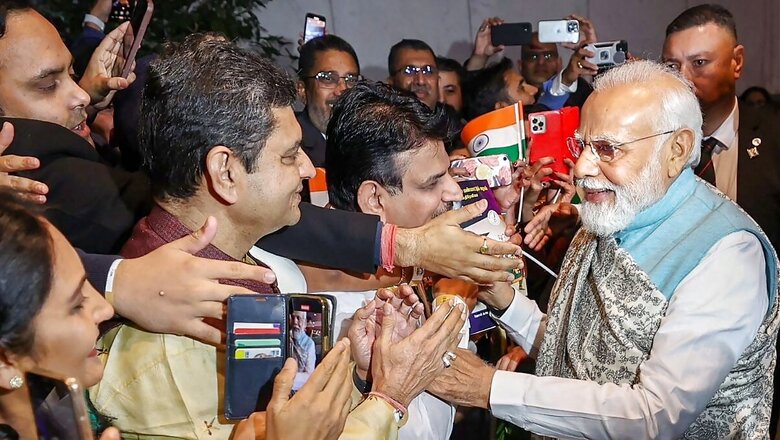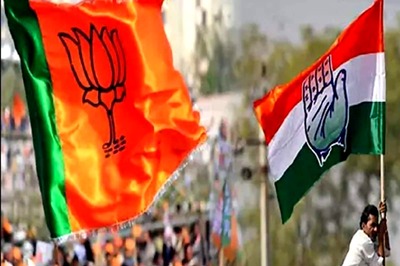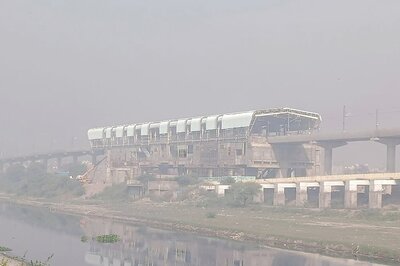
views
Prime Minister Narendra Modi just returned from his three-country tour to Japan, Papua New Guinea and Australia. With this, a significant diplomatic outreach by the current government towards East Asia and the Pacific also concluded. What stood apart in the many engagements that PM Modi undertook during his visit is the way in which the diaspora has been courted. The visuals of a power-packed crowd from Qudos Bank Arena in Sydney not only tells a story of how much the diaspora values their Indian connection but also how the current government values engagement with them.
In the last nine years, diaspora outreach has emerged as a key pillar of the Bharatiya Janata Party (BJP) government’s foreign policy. Whether it is in the US, the UK, Australia or even in the UAE, every visit by PM Modi abroad is marked by a meeting with the Indian community. Sometimes this is undertaken through big-ticket events such as the one in Sydney or the Howdy Modi event held in Texas in 2019. At other times, due to a paucity of time, the PM engages with the diaspora on the sidelines either by ensuring their presence at key bilateral events or by shaking hands with them at the airport. These engagements during foreign visits aside, the government is also investing in the diaspora through key initiatives such as the regional ‘Pravasi Bharatiya Diwas’ celebrations organised at international venues or the ‘Know India Programme’ and ‘Study In India’ programme among others.
The diaspora outreach by the current government has even come under the target of the Opposition who are accusing the PM of visiting Australia despite the cancellation of the Quad summit. But how do you explain the new-age drivers of foreign policy to someone who is still living in the Stone Age? Ironically, the diaspora had played a huge role in India’s struggle for independence itself. All of us have heard the story of Mahatma Gandhi but how many of us know about Lala Hardayal? A Hindu born in New Delhi, who had led the movement against British rule by mobilising the Indian-American community in the US. Another key personality in the diaspora community was Shyam Ji Krishna Verma, a professor at Oxford and founder of India House in London that later became the centre for Indian freedom fighters such as Savarkar and Madam Cama.
As soon as India secured independence, the contribution of this diaspora community was forgotten. During the Nehruvian era, there was a thrust on treating these non-resident Indians with a sense of apologia. On one hand, there was unsaid pressure on them to assimilate and integrate with their new homes instead of taking an active interest in the politics of India and on the other hand, they were treated like a stigma. After independence, due to a shackled socialist economy, India wasn’t able to provide a platform for many brilliant minds to shine. Naturally, they sought better shores in search of which they reached developed economies such as the United States and Britain. As a consequence, in India, they were declared as “brain drain.” Their portrayal in popular media also didn’t leave any stone unturned to shame them as traitors. Bollywood movies and music often invoked the ‘Pardesi’ jibe to send the Indian diaspora on guilt-trip.
Fast forward to the Madison Square Garden event held in New York in 2014. A crowd, of no less than 19,000, cheered loudly as Prime Minister Modi addressed them from the podium. The Indian diaspora that had been silently watching the India story from the sidelines was, for the very first time, given a voice to articulate their opinions in front of its tallest leader. Say what you wish because Modi is listening. It is this diaspora connect that had been missing for a long time. The Indian community across the world has proved its mettle by emerging as one of the richest, highly educated and disciplined people. Their contribution to Western societies has been so huge that today, they are literally ruling the political as well as business corridors in key cities. What PM Modi has done is that he has spotted the diaspora opportunity. Now the diaspora is no more a brain drain. It is a bridge between the developed West and aspirational India. They can lobby to get India considerable influence in the form of favourable business deals. They can even bring their original home and adopted home closer by acting as unofficial ambassadors of both countries. Not to forget the role that they played during the signing of the Civil Nuclear Deal between India and the US.
As India continues to rise, these non-resident Indians can secure even greater influence for India and its aspirations abroad. It is for this reason that the prime minister pitches India’s flagship programs such as ‘Make in India’ and ‘Digital India’ during every outreach. The PM knows that despite living in a foreign country for decades, the diaspora believes in the India story. They actively want to be a part of it. India also needs as many friends as possible and who is better than our own non-resident Indians?
The author is a PhD in International Relations from the Department of International Relations, South Asian University. Her research focuses on political economy of South Asia and regional integration. Views expressed are personal.



















Comments
0 comment